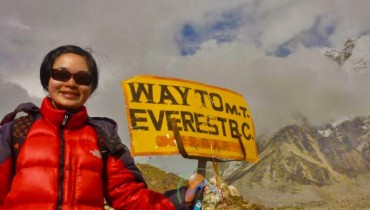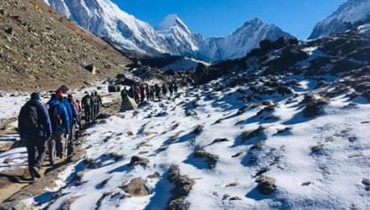How hard is the Annapurna Base Camp Trek?

The Annapurna Base Camp Trek is one of the popular treks in Nepal. But how hard is the trek to Annapurna Base Camp? This article will help you to find an answer to the above question.
The ABC trek is shorter, lower, and easier than the well-known Everest treks, and the base camp is easily reachable to any motivated and somewhat fit trekker.
The chilly dawn sun sends an orange glow across a vast cirque of vertical rock and ice that extends upward to the top of Annapurna 1, the tenth-highest mountain on Earth (8091m). A group of amazed hikers may be seen far below in the shadow of the mountains. They have been steadfastly traveling the challenging trail to the renowned Annapurna Base Camp for the past week, and now they have at last arrived at their destination.
The Annapurna Base Camp Trek, also known as the Annapurna Sanctuary Trek, is a great introduction to trekking in Nepal and may be the most well-known trek overall.
The Annapurna Base Camp Trek is a moderate hike. It requires little preparation and takes just 7-12 days (depending on the route chosen). The trek goes through paddy fields, rhododendron forests, imposing gorges, alpine meadows, and traditional villages before arriving base camp of Annapurna.
It's simple to understand why the Annapurna Base Camp Trek is so well-known when you consider the stunning scenery, ease of access (the trails start just an hour outside of Pokhara), excellent facilities along the route, including some of the best trekking lodges in Nepal, and a good mix of friendly foreign trekkers and locals to keep you company along the trail.
But let's dig a little further into the challenges of the trek to Annapurna Base Camp.
Annapurna Base Camp Information
The Annapurna Base Camp is situated at the lap of Mount Annapurna (8091m), the tenth-highest mountain in the world. It is located southern side of Pokhara at an elevation of 4130m above sea level.
The largest conservation area in Nepal, the Annapurna Conservation Area, encircles the Annapurna Massif. As a result, you will require permits to enter this area. There have been a number of top-notch treks in this area.
The Annapurna Sanctuary includes Annapurna Base Camp as well. The area is home to Gurung people who have been living here for hundreds of years. These people are also well-known as Gurkhas.
You will be enthralled by the incredible hospitality shown by these people. Because of their friendliness, you will have a more enjoyable and worthwhile visit. What makes the Annapurna Base Camp Trek most sought-after is the abundance of high Himalayas, quaint villages throughout the trail, lush forests, and scenic surroundings.
The trails of Annapurna Base Camp Trek pass through many beautiful towns and villages. You get to learn a lot about the Himalayan people and their lifestyles on this trek.
How many days should I spend on ABC Trek?
If you're a novice hiker, you might be concerned about your ability to continue putting one foot in front of the other for extended periods of time. The good news is that you can adjust the length of the Annapurna Base Camp hike to fit your needs. It can be finished in a week at its shortest (though this can require some long and challenging days), but you can also happily spread the adventure out over 12 days. Most people give themselves 10 days, which is just long enough to seem like a true journey while yet being brief enough to prevent enthusiasm from waning.
You will travel 110km during the course of these ten days. That amounts to just ten kilometers every day on average. You can argue that this distance is not challenging, but this distance ignores the fact that nearly none of the 110km are on a pleasant, simple, flat trail. Nearly the entire route is uphill or downhill, and occasionally it can seem like you're doing both at once! And it becomes tiresome.
You should prepare to walk continuously for 5-6 hours each day on average. There are shorter days. Some are considerably longer.
Is the Annapurna Base Camp Trek hard?
The response to this question is somewhat influenced by your viewpoint and prior walking experience. Any trek in the Himalayas usually involves a lot of uphill and downhill walking, which, when paired with the lower portions of this route's lack of oxygen, can quickly deplete energy. However, in comparison to many other treks in Nepal, this one is one of the shorter, lower, and simpler treks and the base camp is well within reach of any motivated and relatively fit trekker.
Soo many stairs again and again..!
Did we mention the stairs when we explained to expect a lot of ups and downs? No..? On this trail, there are a lot of roughly hewn stone steps. And what's this? They are all different sizes from one another. Although it might not seem like much of a challenge now, your leg muscles will despise you after a day of carrying yourself up and down thousands of stairs!
Could I experience altitude sickness?
The highest point of this breathtaking trip is 4130m. Yes, there is a risk because altitude sickness can happen at any elevation above around 3000m. The good news is that this journey gains height at a moderate rate, which is crucial because the faster you climb, the more likely it is that you will experience difficulties associated to altitude. You should be fine if you take it easy, observe the evening rest stops that are advised (they are designed to reduce the risk of altitude sickness), and don't feel pressured to move more quickly or forcefully than you are comfortable with.
Meals and accommodations
Nothing can be better after a rough walking up and down mountain slopes than a hearty meal and a cozy bed. Additionally, the amenities along the Annapurna Base Camp trek are the best available in the mountains of Nepal. The majority of the trekking lodges provide a variety of menu items, from yak meat steaks to Nepal's famous apple pie. Even some of the lodges offer private rooms, electricity, hot showers, and wi-fi. This is fancy-schmancy teahouse trekking!
Are there any drawbacks?
Actually not! But with unmatched alpine beauty, first-rate amenities, and simple access, this is clearly not a peaceful, contemplative trek. Each year thousands of hikers may choose this trail, and occasionally, foreign trekking culture may influence local culture. In the peak season, lodges may be fully booked. Try to arrive at the overnight stop early, sign up for an organized camping trip, or contact your trekking agency to try and make prior reservations for rooms (but be cautioned that not all reservations are honored!).
How can I make this trek easier if I find it too hard?
You will have times when you want to give up, most likely when faced with any unforeseen situation. And there are certain methods to make the challenge easier.
Probably the best strategy is to carry less weight. You'll undoubtedly encounter a lot of solo hikers gasping, sweating, and cursing while carrying a rucksack that is nearly their size. Spend a few extra dollars every day on a porter who will transport the bulk of your gear, and you'll soon be skipping merrily along the route with nothing but a little backpack containing the necessities for that day's hike.
Should I hire a guide?
The route finding is not a challenging task during this trek. Thus, a guide is not the ‘most needed' for this journey. However, we recommend you hire a guide (should be Nepal Government licensed). The mountain weather can change quickly, and a guide is better acquainted with the trails, rest areas, and they know health aspects more than you. Nevertheless, these are still high mountains. A professional guide will also point out noteworthy locations, describe the local way of life, and generally make sure your walk is enjoyable and secure. Due to these, we always advise hiring a guide on Himalayan treks.
Trip Highlights
- Witness the majestic Himalayan panorama of Annapurna massif, Hiunchuli (6441m), Machhapuchhre (6997m), Nilgiri (7061m), and Gangapurna (7454m)
- Explore the Annapurna Conservation Area and enjoy its biodiversity
- Trek through the scenic Gurung villages in a traditional setting
- Enjoy the majestic panorama of the mountains and Kali Gandaki valley from Poon Hill
Itinerary Suggestion
Day 01: Arrival in Kathmandu (1,300m)
Day 02: Drive to Pokhara
Day 03: Pokhara– Nayapul – Ulleri (1,960m): 1½hrs Drive, 5-6hrs trek
Day 04: Ulleri - Ghorepani (2,880m), 5-6hrs trek
Day 05: Hike up to Poon Hill (3,210m) - Ghorepani – Tadapani (2,630m), 7-8hrs trek
Day 06: Tadapani - Sinwa (2360m), 5-6hrs trek
Day 07: Sinwa – Himalaya Hotel (2,920m), 6-7hrs trek
Day 08: Himalaya Hotel – Annapurna Base Camp (4,130m), 6-7hrs trek
Day 09: Annapurna Base Camp – Bamboo (2,300m), 5-6hrs trek
Day 10: Bamboo – Jhinu Danda (1,780m), 5-6hrs trek
Day 11: Jhinu Danda – Nayapul – Pokhara (820m), 5-6 hrs trek and 1½ hrs drive
Day 12: Drive to Kathmandu
Day 13: Final departure
Find your best time!
First, in order to know what you have to pack in regards to weather and temperature, you should know when is the best time to go to Nepal. Though you can trek in Nepal throughout the year, most of the trekkers land in Kathmandu between fall and spring—the peak seasons.
Fall Months (September-November) – Fall is the most popular season. The sky stays often clear and sunny. Temperature is mild, though November is technically when the temperature begins dropping; and there is little precipitation. The only downside is a load of tourists makes the teahouse trails overcrowded.
Winter Months (December-February) – Some experienced trekkers buy their flights to Nepal for winter trips, though the period is considered the off-season. The temperature is bitter, the daylight hours are short, and sudden storms can disrupt travel plans. Also, heavy snowfall will cut off popular high passes.
Spring Months (March-May) – The second popular trekking season in Nepal is Spring. The snow from the previous winter begins to melt, and the landscape turns into a rainbow of color. The trails also become crowded, and the sky will be slightly hazy at lower elevations.
Monsoon Months (June-August) – Landslides and flooding might make your trek unpleasant. The weather is hot and humid, and the sky is constantly covered in threatening clouds. It is always better to avoid monsoon season if you can. Some rain-shadow zone such as Mustang and Dolpo are considerable during the Monsoon.
In conclusion
Right, let's go on. The Annapurna Base Camp Trek is justifiably considered one of the iconic Himalayan hikes. It's difficult enough for most people to feel like a real adventure, but not impossible for just buff Hercules types to complete! Overall, we would describe it as a moderately difficult walk that is ideal for a first Himalayan trip. However, even seasoned mountaineers can shed a tear of happiness when walking through this trail because of the breathtaking view.
Dream Big! Dream Travel!!
Quick Inquiry

Everest Base Camp Trek- An Adventurous and Joyous Trekking ever

Trekking In Nepal - Tourists' First Choice


